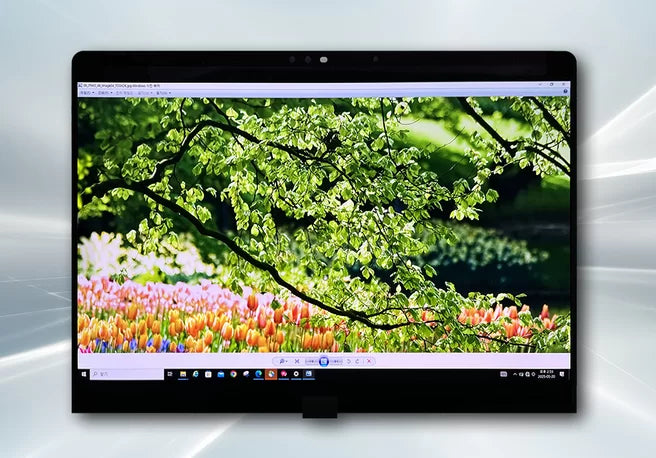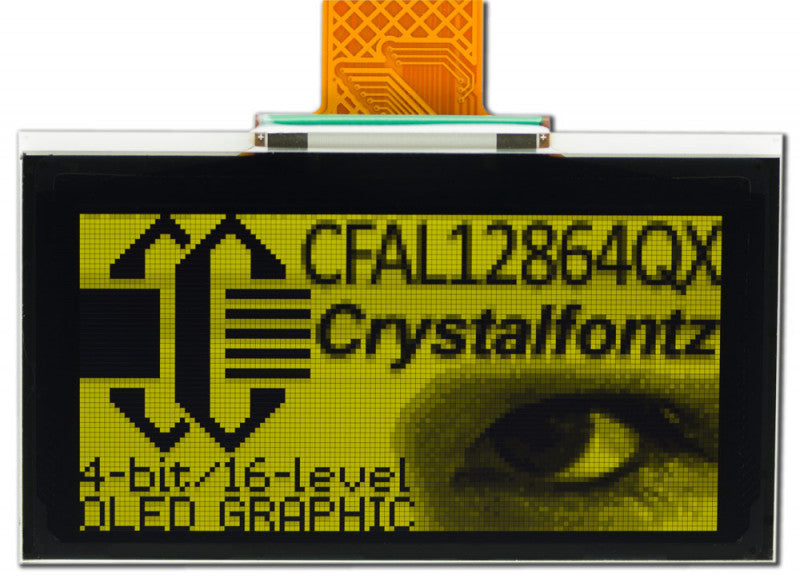PMOLED and AMOLED are OLED display variants differing in driving technology: PMOLED uses a passive matrix, offering low cost but limited to small applications like wearables with refresh rates around 60Hz, while AMOLED's active matrix enables high efficiency and contrast ratios exceeding 100,000:1.
How They Work Differently
For example, a 1.3-inch PMOLED common in fitness trackers uses ~30 rows and 30 columns of electrodes, forcing it to refresh the entire display line by line, which caps its effective refresh rate at ~60Hz and makes large screens impractical—most PMOLEDs max out at 2 inches diagonally due to increasing power loss from overlapping drive signals.
This eliminates the need for line-by-line scanning: a 6.7-inch AMOLED phone screen can update specific pixels independently, slashing response times to <1ms compared to PMOLED’s ~10ms lag. The TFT layer also enables finer control—AMOLEDs achieve >1,000,000:1 static contrast ratios because individual pixels can fully power down, whereas PMOLEDs dim by reducing current across entire rows, limiting contrast to ~1,000:1.
Key mechanical differences include:
-
river circuit complexity: PMOLEDs use external ICs for row/column timing; AMOLEDs integrate TFTs directly onto the glass substrate.
-
ower scaling: PMOLED efficiency drops sharply with size—at 1 inch, it uses ~5mW/cm², but jumps to ~50mW/cm² at 2 inches. AMOLED power stays steady at ~8–12mW/cm² across 1–7-inch sizes.
-
ifespan impact: PMOLED’s constant row activation stresses organic layers, reducing lifespan to ~20,000 hours at full brightness. AMOLED’s pixel-level control extends this to ~50,000 hours under similar conditions.
|
Feature |
PMOLED |
AMOLED |
|---|---|---|
|
Pixel Control |
Row/column electrode scanning |
Dedicated TFT per pixel |
|
Max Practical Size |
2 inches |
7+ inches (e.g., foldables) |
|
Refresh Rate |
~60Hz |
<1ms (effectively unlimited for displays) |
|
Contrast Ratio |
~1,000:1 |
>1,000,000:1 |
|
Power Efficiency (1–2”) |
Drops from 5mW/cm² to 50mW/cm² |
Steady 8–12mW/cm² |
|
Typical Lifespan |
~20,000 hours |
~50,000 hours |
These differences explain why PMOLED dominates cheap wearables—its simple structure cuts costs to ~3 per panel, contrast, and responsiveness justify its ~15 panel cost.
Where You Find Them
PMOLED fits into tiny, budget-friendly gear—60% of digital fitness trackers and basic smartwatches use: 90% of premium smartphones (think iPhones or Samsung Galaxies) and 75% of foldables rely on it, plus many TVs and mid-range wearables.
You’ll spot PMOLED first in entry-level fitness trackers—brands like Fitbit’s Inspire 3 or Garmin’s Vivosmart 5 use it for their 1.1–1.3-inch screens because it’s dirt-cheap (3 per panel) and simple enough for showing steps, heart rate, and battery life. PMOLED’s ~60Hz refresh rate handles static numbers just fine, and its low power draw (~5mW/cm² at 1 inch) keeps batteries lasting 5–7 days.
Next, calculators and electronic shelf labels (ESLs)—Casio’s classic CA-53W calculator still rocks a 0.8-inch PMOLED, and supermarkets love PMOLED ESLs: they sip power so slowly (<1mW/cm²) that price tags stay updated for 5+ years without battery changes. Even medical gear like glucose meters picks PMOLED, and its low cost keeps meters under $20 for users. But PMOLED hits a wall at size: try to make a 3-inch screen, and power use skyrockets to ~50mW/cm², making it hot, inefficient, and useless for anything beyond tiny gadgets.
Premium smartphones are its cash cow—70% of all AMOLED panels ship to phones like the iPhone 15 Pro or Samsung Galaxy S24 Ultra. These screens use AMOLED’s per-pixel control for >1,000,000:1 static contrast, so blacks look actually black(not gray like LCDs), and peak brightness hits 1750 nits. Foldable phones like the Samsung Galaxy Z Fold 5 depend on AMOLED entirely: its flexible TFT substrate bends up to 200,000 times without breaking.
AMOLED also owns large TVs—LG’s C3 OLED TV crams AMOLED into 83-inch panels with perfect blacks and infinite contrast, while a PMOLED TV is literally impossible (max size 2 inches). Even mid-range wearables now upgrade to AMOLED: Apple Watch Ultra ditched PMOLED in 2022, paying ~$12 per panel to get better color accuracy and <1ms response time. PMOLED’s ~10ms lag would make scrolling feel choppy.
Market numbers prove this split: Omdia reports 1.2 billion PMOLED panels shipped in 2023, almost all for small screens. AMOLED? 5.8 billion panels, with phones taking 70% and foldables growing at 35% year-over-year. Car displays are next—analysts say AMOLED will be in 25% of new cars by 2027, thanks to its brightness (up to 2000 nits for HUDs) and flexibility (for curved dashes).

Comparing Image Quality
AMOLED hits >1,000,000:1 static contrast (true blacks from per-pixel shutdown) vs PMOLED’s ~1,000:1 (rows dim together, graying blacks), <1ms response time (zero blur) crushes PMOLED’s ~10ms (faint trails), and covers 95% sRGB/85% DCI-P3 color gamut vs PMOLED’s 70% sRGB.
Try scrolling a news app on an iPhone 15 Pro (AMOLED) vs a Garmin Vivosmart 5 (PMOLED): the latter leaves faint trails behind moving headlines. DisplayMate tests confirm top AMOLEDs have Delta E <2 (near-perfect color), while PMOLEDs hover at 3–5.
Viewing angles add another layer: AMOLED keeps colors consistent at 178 degrees. PMOLED maxes out at 120 degrees.
Brightness matters too: AMOLED peaks at 1750 nits (sunlight-readable on phones or car HUDs), while PMOLED tops at 500 nits, and PMOLED’s glow fades to a dim blur. Longevity hits image quality too: AMOLED’s pixel-level control slows color decay—after 5,000 hours, it stays within 5% of original color. PMOLED’s row-scanning wears out blues fastest—after 3,000 hours (a year of daily use), your Fitbit screen looks yellowish—10% color shift, per DisplayMate. That’s why foldables like the Galaxy Z Fold 5 stick with AMOLED: its color stays vivid after 200,000 bends.
Market stats back this: Omdia found 92% of AMOLED phone users rate color/contrast “excellent,” vs just 65% of PMOLED wearable users.
Power and Lifespan Factors
PMOLED sucks more power as it gets bigger—1.3-inch fitness trackers burn ~5mW/cm², but crank that to 2 inches and it jumps to ~50mW/cm²—while AMOLED keeps power flat at ~8–12mW/cm² no matter the size. Lifespan splits too: PMOLED’s row-scanning fries organic layers, dying to ~20,000 hours at full brightness, while AMOLED’s pixel-level control stretches that to ~50,000 hours.
That’s why a tiny 0.8-inch calculator PMOLED sips <1mW/cm² (lasts years on a button cell), but a 2-inch PMOLED smartwatch? It’ll drain your battery in 3 days flat if you leave the screen on, which uses ~10mW/cm² to keep its 1.92-inch screen alive for 36 hours of heavy use. That’s why foldables like the Samsung Galaxy Z Fold 5 (with a 7.6-inch AMOLED) can handle 12 hours of video playback without overheating: no row-scanning chaos, just targeted power.
PMOLED’s constant row activation wears out the blue organic layer fastest (blues degrade quicker than red/green), so after 3,000 hours (about a year of daily use), your Fitbit Inspire 3’s screen starts looking yellowish—10% color shift measured by DisplayMate. AMOLED avoids this: since each pixel is independent, there’s no “scanning” stress—after 5,000 hours, an LG C3 OLED TV’s color stays within 5% of original, so blacks still look black, not faded gray.
Omdia found 78% of PMOLED wearable users complain about screen dimming after 2 years, versus just 32% of AMOLED phone users. Medical glucose meters stick with PMOLED not for lifespan, but because they only update once every few minutes—low usage means the ~20,000-hour rating is plenty. AMOLED’s efficiency and longevity win: a Samsung Galaxy S24 Ultra’s AMOLED will still look crisp at 50,000 hours—that’s 13 years of 10 hours a day use.
Making the Right Choice
Choosing between PMOLED and AMOLED comes down to three non-negotiables: PMOLED dominates tiny, budget gear (<2 inches, 3 per panel)—80% of fitness trackers like Fitbit Inspire 3 use it—while AMOLED rules bigger, premium screens (15 per panel) where contrast or speed matters—90% of premium phones (iPhone 15 Pro, Samsung S24 Ultra) and 75% of foldables rely on it.
Size is your first hard limit—PMOLED’s passive matrix design physically caps at 2 inches diagonally. Push beyond that, and power use explodes from 5mW/cm² at 1 inch to 50mW/cm² at 2 inches—why electronic shelf labels (ESLs) or Casio’s 0.8-inch calculator stick with it: they don’t need flashy visuals, just small, cheap screens that sip power. AMOLED? Its active matrix with TFTs bends 200,000 times without damage (perfect for Galaxy Z Fold 5’s 7.6-inch foldable) and scales to 83-inch TVs (LG C3 OLED) without losing quality. If you’re building something larger than 2 inches.
Cost is next—PMOLED’s simplicity saves cash: 3 per panel vs AMOLED’s 15. Fitbit keeps its Inspire 3 under , which most budget buyers skip. But AMOLED’s premium pays off for flagships: Apple Watch Ultra charges $799 extra for its AMOLED screen, and users justify it for better color accuracy (Delta E <2 vs PMOLED’s 3–5) and faster response (<1ms vs 10ms) when tracking outdoor runs.
AMOLED’s >1,000,000:1 static contrast (pixels fully turn off) beats PMOLED’s ~1,000:1 (rows dim together). AMOLED’s <1ms response eliminates blur—swipe TikTok on an iPhone 15 Pro (AMOLED) vs a Garmin Vivosmart 5 (PMOLED). For low-power, long-life gear like glucose meters, PMOLED’s ~5mW/cm² draw works—after 20,000 hours (a year of daily use), it’s still readable. But for daily drivers? AMOLED’s ~50,000-hour lifespan means it won’t fade—Tesla’s Model 3 center screen stays crisp for 10 years; a PMOLED would be blurry by year 5.
Omdia’s 2023 data backs this: 1.2 billion PMOLED panels shipped. 5.8 billion panels, with 70% going to phones. 92% of AMOLED phone users call image quality “excellent”; just 65% of PMOLED wearable users do.
En lire plus

PMOLED, short for Passive Matrix OLED, is a display tech using simple row-column electrode grids to light pixels sequentially, perfect for small screens like smartwatch faces; two standard polymer ...

This IPS Display Guide covers types (standard, Nano IPS), pros like 178-degree viewing angles and ΔE<2 color accuracy, and use cases: favored by designers for precise hues, photographers for tru...



Laisser un commentaire
Ce site est protégé par hCaptcha, et la Politique de confidentialité et les Conditions de service de hCaptcha s’appliquent.